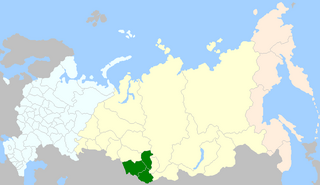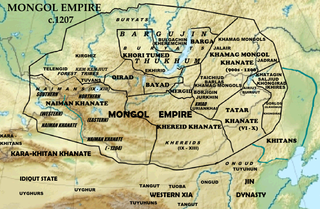Related Research Articles

The Bulgars were Turkic semi-nomadic warrior tribes that flourished in the Pontic–Caspian steppe and the Volga region during the 7th century. They became known as nomadic equestrians in the Volga-Ural region, but some researchers say that their ethnic roots can be traced to Central Asia. During their westward migration across the Eurasian steppe, the Bulgar tribes absorbed other tribal groups and cultural influences in a process of ethnogenesis, including Iranian, Finnic and Hunnic tribes. Modern genetic research on Central Asian Turkic people and ethnic groups related to the Bulgars points to an affiliation with Western Eurasian populations. The Bulgars spoke a Turkic language, i.e. Bulgar language of Oghuric branch. They preserved the military titles, organization and customs of Eurasian steppes, as well as pagan shamanism and belief in the sky deity Tangra.

The Turkic peoples are a collection of ethnic groups of Central, East, North and West Asia as well as parts of Europe and North Africa, who speak Turkic languages.

The Kara-Khanid Khanate, also known as the Karakhanids, Qarakhanids, Ilek Khanids or the Afrasiabids, was a Turkic khanate that ruled Central Asia in the 9th through the early 13th century. The dynastic names of Karakhanids and Ilek Khanids refer to royal titles with Kara Khagan being the most important Turkic title up till the end of the dynasty.

The Oguz or Ghuzz Turks were a western Turkic people that spoke the Oghuz branch of the Turkic language family. In the 8th century, they formed a tribal confederation conventionally named the Oghuz Yabgu State in Central Asia. The name Oghuz is a Common Turkic word for "tribe". Byzantine sources call the Oghuz the Uzes. By the 10th century, Islamic sources were calling them Muslim Turkmens, as opposed to shamanist or Buddhist. By the 12th century, this term had passed into Byzantine usage and the Oghuzes were overwhelmingly Muslim. The term "Oghuz" was gradually supplanted among the Turks themselves by Turkmen and Turcoman, from the mid-10th century on, a process which was completed by the beginning of the 13th century.

The Kipchaks, also known as Kipchak Turks, Qipchaq or Polovtsians, were a Turkic nomadic people and confederation that existed in the Middle Ages, inhabiting parts of the Eurasian Steppe. First mentioned in the 8th century as part of the Second Turkic Khaganate, they most likely inhabited the Altai region from where they expanded over the following centuries, first as part of the Kimek Khanate and later as part of a confederation with the Cumans. There were groups of Kipchaks in the Pontic–Caspian steppe, Syr Darya and Siberia. The Cuman–Kipchak confederation was conquered by the Mongols in the early 13th century.

The Cumans, also known as Polovtsians or Polovtsy, were a Turkic nomadic people comprising the western branch of the Cuman–Kipchak confederation. After the Mongol invasion (1237), many sought asylum in the Kingdom of Hungary, as many Cumans had settled in Hungary, the Second Bulgarian Empire playing an important role in the development of the state, and Anatolia before the invasion.
The Yemek was a Turkic speaking tribe known from Arab and Persian medieval geographers as one of the seven tribes in the Kimek confederation in the period of 850–1050 AD. The other six constituent tribes, according to Abu Said Gardizi, were the Imur, Tatars, Bayandur, Kipchaks, Lanikaz, and Ajlad.

The Kimek–Kipchak confederation was a medieval Turkic state formed by seven peoples, including the Yemeks and Kipchaks, in the area between the Ob and Irtysh rivers. From the end of the 9th century to 1050, it existed as a khaganate, and as a khanate until the Mongol conquest in the early 13th century.

The Kumandins are a Turkic indigenous people of Siberia. They reside mainly in the Altai Krai and Altai Republic of the Russian Federation. They speak the Northern Altai Kumandin language.

The Eurasian nomads were a large group of nomadic peoples from the Eurasian Steppe, who often appear in history as invaders of Europe, Western Asia, Central Asia, Eastern Asia, and Southern Asia.
Turkic migration refers to the spread of Turkic tribes and Turkic languages across Eurasia and between the 6th and 11th centuries. In the 6th century, the Göktürks overthrew the Rouran Khaganate in what is now Mongolia and expanded in all directions, spreading Turkic culture throughout the Eurasian steppes. Although Göktürk empires came to an end in the 8th century, they were succeeded by numerous Turkic empires such as the Uyghur Khaganate, Kara-Khanid Khanate, Khazars, and the Cumans. Some Turks eventually settled down into a sedentary society such as the Qocho and Ganzhou Uyghurs. The Seljuq dynasty settled in Anatolia starting in the 11th century, resulting in permanent Turkic settlement and presence there. Modern nations with large Turkic populations include Kyrgyzstan, Turkmenistan, Turkey, Uzbekistan and Kazakhstan, and Turkic populations also exist within other nations, such as Chuvashia, Bashkortostan, Tatarstan, the Crimean Tatars, the Kazakhs in Mongolia, the Uyghurs in China, and the Sakha Republic in Siberia.

The Bayandur or Bayundur, was one of the 24 Oghuz Turkic tribes. Originally one of the 7 original tribes that made up the Kimek confederation, they later joined the Oghuz Turks. The Bayandur originated from Central Asia.
The Lanikaz was a Turkic tribe or clan. They were one of seven original tribes that made up the Kimek confederation. They originated from the Central Asian steppes.

Yueban, colloquially: "Weak Xiongnu", was the name used by Chinese historians for remnants of the Northern Xiongnu in Zhetysu, now part of modern-day Kazakhstan. In Chinese literature they are commonly called Yueban. The Yuebans gained their own visibility after disintegration of the Northern Xiongnu state, because unlike the main body of the Northern Xiongnu, who escaped from the Chinese sphere of knowledge, the Yueban tribes remained closer to China.

The Oghuz Yabgu State was a Turkic state, founded by Oghuz Turks in 766, located geographically in an area between the coasts of the Caspian and Aral Seas. Oghuz tribes occupied a vast territory in Kazakhstan along the Irgiz, Yaik, Emba, and Uil rivers, the Aral Sea area, the Syr Darya valley, the foothills of the Karatau Mountains in Tien-Shan, and the Chui River valley. The Oghuz political association developed in the 9th and 10th centuries in the basin of the middle and lower course of the Syr Darya and adjoining the modern western Kazakhstan steppes.

Kangar union, Kazakh: Қaңғар Oдағы was a Turkic state in the territory of the entire modern Kazakhstan without Zhetysu. The ethnic name Kangar is an early medieval name for the Kangly people, who are now part of the Kazakh, Uzbek, and Karakalpak nations. The capital of the Kangar union was located in the Ulytau mountains. The Pechenegs, three of whose tribes were known as Kangar, after being defeated by the Oghuzes, Karluks, and Kimek-Kypchaks, attacked the Bulgars and established the Pecheneg state in Eastern Europe.

Tatar was one of the five major tribal confederations (khanlig) in the Mongolian Plateau in the 12th century.

This article summarizes the History of the western steppe, which is the western third of the Eurasian steppe, that is, the grasslands of Ukraine and southern Russia. It is intended as a summary and an index to the more-detailed linked articles. It is a companion to History of the central steppe and History of the eastern steppe. All dates are approximate since there are few exact starting and ending dates. This summary article does not list the uncertainties, which are many. For these, see the linked articles.
The Tatar was one of seven Turkophone original tribes that made up the Kimek confederation, along with the Īmī, Īmāk, Bayāndur, Khifchāq, Nilqāz and Ajlad. The Tatār were the third in order. The Kimek tribes originated in the Central Asian steppes, and had migrated to the territory of present-day Kazakhstan. The Tatar, as part of the Kimek, were mentioned by Gardizi.

This is a short History of the central steppe, an area roughly equivalent to modern Kazakhstan. Because the history is complex it is mainly an outline and index to the more detailed articles given in the links. It is a companion to History of the western steppe and History of the eastern steppe and is parallel to the History of Kazakhstan and the History of central Asia.
References
- 1 2 3 Agajanov 1992, p. 69.
- 1 2 Kimball 1994.
- ↑ See Agajanov 1992 , p. 69 and Kimball 1994
- ↑ Bosworth 2017.